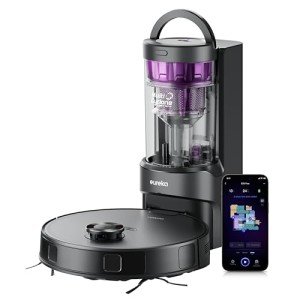15 Unquestionably Reasons To Love Robot Vacuum Cleaner
The Rise of Robot Vacuum Cleaners in Industrial Settings
Recently, the landscape of industrial cleaning has actually seen a substantial change with the introduction of robot vacuum. These automated gadgets are not simply a novelty for homes; they have gotten traction in warehouses, manufacturing plants, and other industrial environments. This article checks out the performance, benefits, and factors to consider of robot vacuum cleaners within the industrial context, while responding to some often asked concerns.
What are Robot Vacuum Cleaners?
Robot vacuum cleaners are automated cleaning devices equipped with sophisticated sensing units and innovation that allow them to browse around areas, detect dirt, and vacuum surfaces without direct human intervention. In robotic vacuums , they are developed to handle a variety of debris types, help with routine cleaning schedules, and enhance overall functional performance.
Table 1: Key Features of Industrial Robot Vacuum Cleaners
Feature
Description
Navigation
Utilizes LiDAR or camera-based navigation for precise mapping.
Size and Design
Compact and robust design to fit in tight spaces and hold up against difficult environments.
Self-Charging
Instantly go back to its docking station for recharging.
Dustbin Capacity
Larger dustbin fit for industrial debris sizes and volumes.
Programs
Can be set for scheduling and particular cleaning tasks.
Information Collecting
Geared up with sensors to collect data for upkeep and cleaning analysis.
Benefits of Robot Vacuum Cleaners in Industrial Settings
The adoption of robot vacuum cleaners features a myriad of advantages:
Increased Efficiency:
- 24/7 Operation: Unlike human cleaners, robots can operate around the clock, contributing to constant cleanliness without downtime.
- Time-Saving: Automated cleaning permits workers to focus on core jobs instead of cleaning tasks.
Cost Savings:
- Labor Costs: Maintaining a robot vacuum can reduce the need for a large cleaning personnel, lowering overall labor costs.
- Operational Efficiency: With improved cleanliness and lowered downtime due to maintenance issues, organizations can save on operational expenses.
Boosted Safety:
- Reduced Risk: By reducing the human involvement in hazardous cleaning environments, the threat of mishaps is lessened.
- Consistent Cleaning: Robot vacuums ensure that locations are consistently cleaned, minimizing slip risks and unhealthy environments.
Increased Flexibility:
- Customizable Cleaning Routes: These devices can be configured to tidy particular locations or floors, adapting to changing industrial designs.
- Range of Surfaces: Industrial robot vacuums can handle numerous floor covering types, from concrete to tiles, making them flexible.
Environmental Impact:
- Sustainable Cleaning Solutions: Many models utilize minimal water and environmentally friendly cleaning options, assisting in corporate sustainability efforts.
Table 2: Industrial Applications of Robot Vacuum Cleaners
Industry
Application
Manufacturing
Cleaning production lines and assembly locations.
Warehousing
Maintaining tidy and organized storage spaces.
Food Processing
Guaranteeing tidiness in delicate locations to meet health standards.
Pharmaceuticals
Maintaining ultra-clean environments for production.
Logistics and Distribution
Keeping pathways clear for effective operation.
Obstacles and Considerations
While the benefits are substantial, companies should likewise consider several obstacles:
- Initial Investment: The upfront expenses of purchasing industrial robot vacuum cleaners can be significant, though long-lasting cost savings might offset this cost.
- Upkeep and Repairs: Regular upkeep is important to keep the robotic systems working optimally, and repair work can sustain extra costs.
- Combination: Businesses might require to integrate these devices into existing workflows, which can need time and modification.
- Training and Support: Staff might require training to successfully handle these devices, especially when repairing or programs is needed.
Frequently Asked Questions About Robot Vacuum Cleaners in Industrial Settings
1. How much do industrial robot vacuum cost?
The cost can range from a few thousand to 10s of thousands of dollars, depending on requirements, functions, and brand name.
2. What kinds of surface areas can they clean up?
Robot vacuum cleaners appropriate for different surfaces including carpets, tiles, concrete, and even some wood floorings.
3. How do they browse intricate industrial environments?
The majority of industrial robot vacuums use advanced navigation systems like LiDAR, electronic cameras, and sensing units to map out and adapt to their surroundings for effective cleaning.
4. Can they clean large areas without human intervention?
Yes, industrial robot vacuums are developed to clean comprehensive locations with pre-programmed paths and schedules, efficiently operating autonomously.
5. Are these robots ecologically friendly?
Numerous models focus on efficiency and decrease water usage, making them a more eco-friendly cleaning choice compared to standard methods.
The intro of robot vacuum into industrial environments signifies an amazing advancement in cleaning innovation. With robotic vacuum cleaners to boost efficiency, decrease labor costs, and preserve safety, these automated systems are leading the way for smarter and cleaner industrial operations. While difficulties might exist, the long-lasting advantages and technological improvements are encouraging for industries seeking to enhance their cleaning procedures. As technology continues to develop, we can expect additional innovations in robot vacuum that will transform industrial cleaning practices a lot more.
